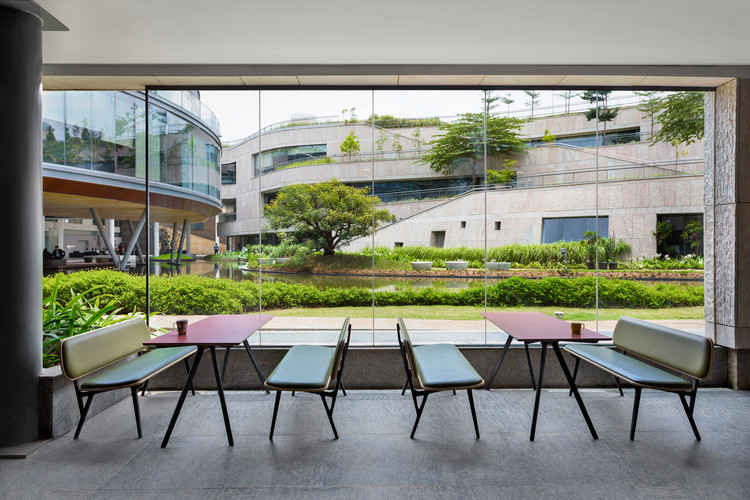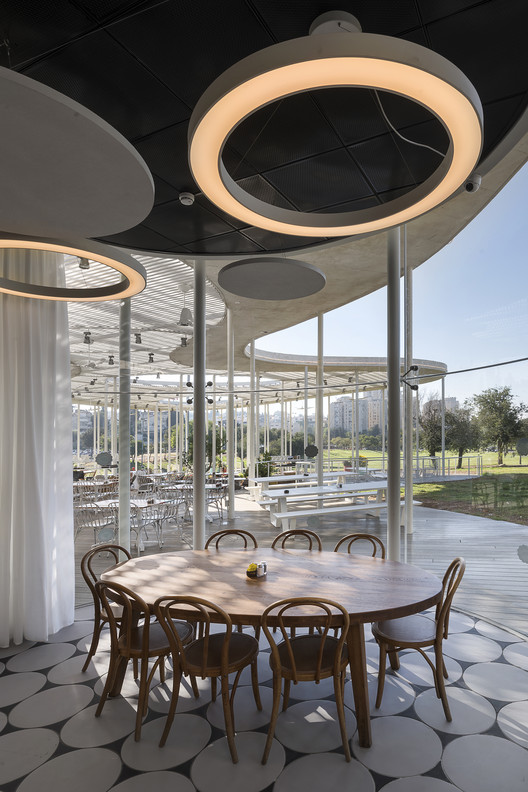Skolkovo Institute of Science and Technology Herzog - de Meuron
2018-11-16 02:30
斯科尔科沃是俄罗斯政府倡议在莫斯科第三圈建立一个新的城市社区,距离克里姆林宫以西17公里。斯科尔科沃的目标是建立一个具有全球声誉的21世纪创新技术中心,包括研究和生产,并为既有的和新兴的公司、学校、研究所和一所新大学建立行政总部。斯科尔科沃大学,作为一个新成立的机构,与斯科尔科沃的其他地区一起成立,其目标是成为莫斯科、俄罗斯和整个世界的杰出教育和研究中心。
Skolkovo is the Russian government initiative for a new urban community at the 3rd ring of Moscow, 17 km west from the Kremlin. Built ex nihilo, the aim of Skolkovo is to create a globally reputed centre for innovative 21st century technology, embracing research and production, with administrative headquarters for both established and emerging companies, schools, institutes, and a new university. The Skoltech University, as a newly founded institution, rises together with the rest of Skolkovo, and aims to be a distinguished educational and research centre for Moscow, Russia and the whole world.
Skolkovo is the Russian government initiative for a new urban community at the 3rd ring of Moscow, 17 km west from the Kremlin. Built ex nihilo, the aim of Skolkovo is to create a globally reputed centre for innovative 21st century technology, embracing research and production, with administrative headquarters for both established and emerging companies, schools, institutes, and a new university. The Skoltech University, as a newly founded institution, rises together with the rest of Skolkovo, and aims to be a distinguished educational and research centre for Moscow, Russia and the whole world.
斯科尔科沃最初的总体规划旨在通过充满活力的公民活动-生活、学习、工作、旅行、购物、放松-创造城市质量。与苏联时期封闭的卫星城镇不同,斯科尔科沃在莫斯科径向网格内形成了一个独特的震中,与其基础设施相结合,包括在其文化生活中,并在视觉上与国立大学塔楼相连。
The original master plan for Skolkovo aims to create urban quality through a vibrant mix of civic activities – living, studying, working, journeying, shopping, relaxing. Unlike the Soviet-era closed satellite towns, Skolkovo forms a distinct epicentre within the radial grid of Moscow, integrated with its infrastructure, included in its cultural life, and visually connected with the State University tower.
The original master plan for Skolkovo aims to create urban quality through a vibrant mix of civic activities – living, studying, working, journeying, shopping, relaxing. Unlike the Soviet-era closed satellite towns, Skolkovo forms a distinct epicentre within the radial grid of Moscow, integrated with its infrastructure, included in its cultural life, and visually connected with the State University tower.
城市规划是围绕着五个单独的地区的理念而发展的,就像城市岛屿,插入了风景如画的景观。这五个区中的每一个都有一个独特的形状,一个特定的项目组合,是由不同的建筑师设计的,赋予了它一个特定的特征和氛围。
The urban scheme develops around the idea of five individual Districts, like urban islands, inserted in the picturesque landscape. Each of the five Districts has a singular shape, a specific program mix and is designed by a different architect, giving it a specific character and atmosphere.
The urban scheme develops around the idea of five individual Districts, like urban islands, inserted in the picturesque landscape. Each of the five Districts has a singular shape, a specific program mix and is designed by a different architect, giving it a specific character and atmosphere.
Herzog & de Meuron designed the conceptual master plan of District 3 with the University as its centrepiece. Comprised of three circular shapes and phases – the East Ring, the Agora and the West Ring – the emerging Skoltech University is envisioned as a nucleus, a distinctive core of the District, and a founding stone of Skolkovo.
Herzog & de Meuron designed the conceptual master plan of District 3 with the University as its centrepiece. Comprised of three circular shapes and phases – the East Ring, the Agora and the West Ring – the emerging Skoltech University is envisioned as a nucleus, a distinctive core of the District, and a founding stone of Skolkovo.
大学东环有一个简单的形式和组织的互锁圆环和矩形块,这直接反映其方案内容和多样性。
The University East Ring has a simple form and organization of interlocked circular rings and rectangular blocks, which directly reflect its programmatic content and diversity.
The University East Ring has a simple form and organization of interlocked circular rings and rectangular blocks, which directly reflect its programmatic content and diversity.
外圈直径280米,内环两个较小,容纳所有共用的学术设施和公共空间。曲线形状将所有区域连接在一个循环中。外环容纳教员办公室、行政和会议空间,内环容纳教学空间,主礼堂位于中央过境点。
An outer ring of 280 metres diameter and two smaller inner rings host all the shared academic facilities and public spaces. The curved shapes connect all zones in a single loop. The outer ring accommodates the faculty offices, administration and meeting spaces, while the inner rings house the teaching and learning spaces, with the main auditorium at the central crossing point.
An outer ring of 280 metres diameter and two smaller inner rings host all the shared academic facilities and public spaces. The curved shapes connect all zones in a single loop. The outer ring accommodates the faculty offices, administration and meeting spaces, while the inner rings house the teaching and learning spaces, with the main auditorium at the central crossing point.
一个由矩形和重复块组成的合理网格在棋盘模式中被放置在与学术研究活动相关的实验室和车间中。为了优化日光,这些区块是面向东西的。这些实验大楼是以7米乘7米的规划和结构网格为基础的,具有相同的宽度,宽度为21或28米,长度不一。这些重复的正交形状提供了合理的模块布局的效率和简单性,并结合实验室和车间空间通常需要的灵活性和适应性。额外的研究设施、装载、后勤和技术区域位于整个建筑物下面的连续地下室地板上。这些实验室和讲习班完成了大学的学术领域,形成了一个相互联系的部门和共享设施的平台。
A rational grid of rectangular and repetitive blocks is laid out in a checkerboard pattern to house laboratories and workshops related to the academic research activities. To optimize daylight the blocks are oriented east-west. The lab blocks are based on a 7 by 7 metre planning and structural grid, and have uniform widths of 21 or 28 metres, with varying lengths. These repetitive orthogonal shapes offer the efficiency and simplicity of rational modular layouts, combined with the flexibility and adaptability generally required for laboratory and workshop spaces. Additional research facilities, loading, logistics, and technical areas are located in the continuous basement floor beneath the entire building. The laboratories and workshops complete the University’s academic area, forming a platform for interconnected departments and shared facilities.
A rational grid of rectangular and repetitive blocks is laid out in a checkerboard pattern to house laboratories and workshops related to the academic research activities. To optimize daylight the blocks are oriented east-west. The lab blocks are based on a 7 by 7 metre planning and structural grid, and have uniform widths of 21 or 28 metres, with varying lengths. These repetitive orthogonal shapes offer the efficiency and simplicity of rational modular layouts, combined with the flexibility and adaptability generally required for laboratory and workshop spaces. Additional research facilities, loading, logistics, and technical areas are located in the continuous basement floor beneath the entire building. The laboratories and workshops complete the University’s academic area, forming a platform for interconnected departments and shared facilities.
块和环之间的叠加和交互创造了一个有趣的建筑质量。这三个环限制和穿透块,把大院连接在一起,形成一个独特的雕塑形式,在外面形成林荫大道,并在里面建立一个连接的庭院网络。尽管它的整体外观,建筑物是多孔的,在街道上,它的所有庭院开放,并向公众开放。最大的庭院-中央场-从所有的圆环和大部分街区都可以看到,也是正式仪式和日常放松的主要目的地。这些院落大小各异,并通过类似不同的通道连接起来,这些通道要么穿过圆环下,要么穿过街区的角落,提供多条穿过大学的小径,并容纳所有进入大楼的公共入口。庭院和东环周围的统一种植,将成为斯科尔特克成熟经验的一个基本要素,并将把莫斯科周围的自然森林与大学景观结合起来。
The overlay and interaction between the blocks and rings create an interesting architectural quality. The three rings circumscribe and penetrate the blocks and connect the compound together into a distinctive sculptural form, which shapes the Boulevard at the outside and creates a network of connected courtyards inside. Despite its monolithic appearance, the building is porous at street level and all its courtyards are open and accessible to the public. The largest of the courtyards – the Central Yard – is visible from all the rings and most of the blocks, and is a main destination for formal ceremonies and everyday relaxation. The courtyards have diverse sizes and are connected via similarly varied passages, which either pass under the rings or carve through the corners of the blocks, offering a multitude of paths through the University, and accommodating all public entrances into the building. The uniform planting of the courtyards and around the East Ring, will become an essential element of the experience of Skoltech as it matures, and will integrate the University landscape with the natural forests around Moscow.
The overlay and interaction between the blocks and rings create an interesting architectural quality. The three rings circumscribe and penetrate the blocks and connect the compound together into a distinctive sculptural form, which shapes the Boulevard at the outside and creates a network of connected courtyards inside. Despite its monolithic appearance, the building is porous at street level and all its courtyards are open and accessible to the public. The largest of the courtyards – the Central Yard – is visible from all the rings and most of the blocks, and is a main destination for formal ceremonies and everyday relaxation. The courtyards have diverse sizes and are connected via similarly varied passages, which either pass under the rings or carve through the corners of the blocks, offering a multitude of paths through the University, and accommodating all public entrances into the building. The uniform planting of the courtyards and around the East Ring, will become an essential element of the experience of Skoltech as it matures, and will integrate the University landscape with the natural forests around Moscow.
大学的圆环和积木覆盖着控制日光和统一正面的鳍,使它们具有整体的纹理和深度。装饰材料区分内部和外部的环和块。圆环内部有天然橡木地板和墙壁系统,外部是西伯利亚落叶松鳍,实验室中有工业乙烯基地板和铝墙系统,外部有白色铝鳍。建筑围护结构由基础上的连续混凝土工作台和顶部连接的倾斜屋顶统一起来,与整体的̧ADE一起,将所有的元素结合在一起,使大学与总体规划中的其他建筑物区别开来。然而,该计划仍然完全与其周围环境相结合。
The University rings and blocks are clad with fins that control the daylight and unify the facades, giving them overall texture and depth. Finish materials distinguish the rings and blocks on the inside and outside. The rings have natural oak floor and wall systems in the interior, and Siberian larch fins on the exterior, while the blocks have industrial vinyl floor and aluminum wall systems in the labs, and white aluminum fins on the exterior. The building envelope is unified by a continuous concrete bench at the base and by connected sloping roofs at the top which, along with the overall façade, bring together all the elements into one integrated whole and set the University apart from the other buildings in the master plan. The scheme nonetheless remains fully integrated with its surroundings.
The University rings and blocks are clad with fins that control the daylight and unify the facades, giving them overall texture and depth. Finish materials distinguish the rings and blocks on the inside and outside. The rings have natural oak floor and wall systems in the interior, and Siberian larch fins on the exterior, while the blocks have industrial vinyl floor and aluminum wall systems in the labs, and white aluminum fins on the exterior. The building envelope is unified by a continuous concrete bench at the base and by connected sloping roofs at the top which, along with the overall façade, bring together all the elements into one integrated whole and set the University apart from the other buildings in the master plan. The scheme nonetheless remains fully integrated with its surroundings.
同时,skoltech公司凭借其低矮的建筑、众多的洞口,以及对室内、一系列可公开进入的庭院和传统材料Herzog的看法,同时具有综合性、渗透性和纪念性。
Skoltech is integrated, permeable and monumental at the same time, by virtue of its low-rise architecture, numerous openings, and views on the interior, the series of publically accessible courtyards, and traditional materials, Herzog & de Meuron 2017
Skoltech is integrated, permeable and monumental at the same time, by virtue of its low-rise architecture, numerous openings, and views on the interior, the series of publically accessible courtyards, and traditional materials, Herzog & de Meuron 2017
Architects Herzog & de Meuron
Location Ulitsa Nobelya, 3, Moscow Oblast, Russia
Partners Jacques Herzog, Pierre de Meuron, Stefan Marbach (Partner in Charge)
Associates, Project Directors Tomislav Dushanov, Tobias Winkelmann
Associate, Project Manager Olga Bolshanina
Project Manager Ilia Tsachev
Client LLC UDPC Skolkovo, Moscow, Russia
 举报
举报
别默默的看了,快登录帮我评论一下吧!:)
注册
登录
更多评论
相关文章
-

描边风设计中,最容易犯的8种问题分析
2018年走过了四分之一,LOGO设计趋势也清晰了LOGO设计
-

描边风设计中,最容易犯的8种问题分析
2018年走过了四分之一,LOGO设计趋势也清晰了LOGO设计
-

描边风设计中,最容易犯的8种问题分析
2018年走过了四分之一,LOGO设计趋势也清晰了LOGO设计






































































